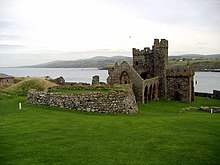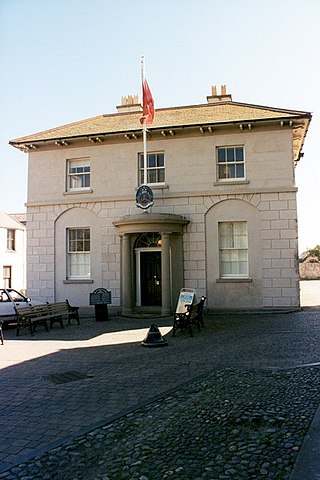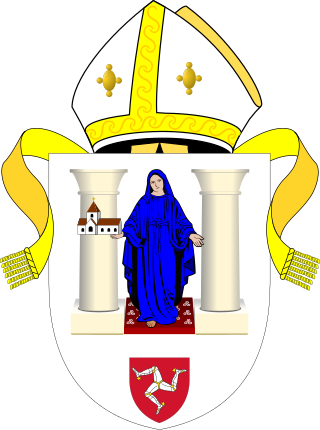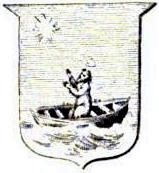

St Patrick's Isle (Manx : Ynnys Pherick) is a small tidal island on the west coast of the Isle of Man in the Irish Sea, largely occupied by the ruins of Peel Castle and of the Pre-Reformation Cathedral of the Diocese of the Isles.


St Patrick's Isle (Manx : Ynnys Pherick) is a small tidal island on the west coast of the Isle of Man in the Irish Sea, largely occupied by the ruins of Peel Castle and of the Pre-Reformation Cathedral of the Diocese of the Isles.

Archeological studies have shown permanent occupation on St Patrick's Isle dating to the Late Bronze Age. [1] The ruins on St Patrick's Isle include St Patrick's Church and an Irish-style round tower, the former St German's Cathedral, and the more recent residence of the Lords of Mann.

St Patrick's Isle is far more important than one might realize to history of the Celtic Church in the British Isles. This is because, prior to the Protestant Reformation, the now ruined St Germanus of Man's Cathedral was the headquarters of the Diocese of the Isles, which in its full form included the Outer Hebrides, most of the Inner Hebrides (including Iona, Skye, Raasay, Canna, Eigg, Coll, Tiree, Mull, Colonsay, Islay, Jura, Gigha – but not Lismore, Kerrera, Seil or Luing, all under the Bishop of Argyll), the Isle of Bute and the Isle of Arran. The Diocese may have originally contained Galloway, a suggestion thought to explain the possible attacks of Wimund on Bishop Gilla Aldan of Whithorn.
The ancient cathedral, however, was left to decay in the 18th century, never to be rebuilt. The island's steep and rocky edges made it an ideal defensive outpost. It is said to be the place where St Patrick first set foot in the Isle of Man in 444 while returning from Liverpool to Ireland. Having established Christianity, he then appointed St Germanus of Man bishop, to oversee further development of the Church. [2] However, there is debate as to whether the name "St Patrick's Isle" pre-dates the thirteenth century. [1]
The islet is now a tourist site with the castle walls running close to the shoreline. There is a public walk around the outside of the castle, which lines the coastal edge of the islet. It is connected to the town of Peel on the Isle of Man by a causeway over Fenella Beach, named after the character in Sir Walter Scott's Peveril of the Peak . In addition to the historic ruins, the island is partially a sealife sanctuary.
St. Patrick's Isle was originally referred to as Inis (or Ynnys) Patraic in Manx.

The Isle of Man had become physically separated from Great Britain and Ireland by 6500 BC. It appears that colonisation took place by sea sometime during the Mesolithic era. The island has been visited by various raiders and trading peoples over the years. After being settled by people from Ireland in the first millennium AD, the Isle of Man was converted to Christianity and then suffered raids by Vikings from Norway. After becoming subject to Norwegian suzerainty as part of the Kingdom of Mann and the Isles, the Isle of Man later became a possession of the Scottish and then the English crowns.

Castletown is a town in the Isle of Man, geographically within the historical parish of Malew but administered separately. Lying at the south of the island, it was the Manx capital until 1869. The centre of town is dominated by Castle Rushen, a well-preserved medieval castle, originally built for a Viking king.

Peel is a seaside town and small fishing port in the Isle of Man, in the historic parish of German but administered separately. Peel is the third largest town in the island after Douglas and Ramsey but the fourth largest settlement, as Onchan has the second largest population but is classified as a village.

The Diocese of Sodor and Man is a diocese of the Church of England. Originally much larger, today it covers just the Isle of Man and its adjacent islets. Today, the bishop's office is in Douglas and the cathedral is in Peel. The diocese is not generally called either "Sodor diocese" or "Man diocese".

Peel Castle is a castle in Peel on the Isle of Man, originally constructed by Norwegians. The castle stands on St Patrick's Isle which is connected to the town by a causeway. It is now owned by Manx National Heritage and is open to visitors during the summer.

Cashel is a town in County Tipperary in Ireland. Its population was 4,422 in the 2016 census. The town gives its name to the ecclesiastical province of Cashel. Additionally, the cathedra of the Roman Catholic Archdiocese of Cashel and Emly was originally in the town prior to the English Reformation. It is part of the parish of Cashel and Rosegreen in the same archdiocese. One of the six cathedrals of the Anglican Bishop of Cashel and Ossory, who currently resides in Kilkenny, is located in the town. It is in the civil parish of St. Patricksrock which is in the historical barony of Middle Third.

The Cathedral Church of Saint German or Peel Cathedral, renamed Cathedral Isle of Man, is located in Peel, Isle of Man. The cathedral is also one of the parish churches in the parish of the West Coast, which includes the town of Peel. Built in 1879–84, it was made the cathedral by Act of Tynwald in 1980.

The culture of the Isle of Man is influenced by its Celtic and, to a lesser extent, its Norse origins, though its close proximity to the United Kingdom, popularity as a UK tourist destination, and recent mass immigration by British migrant workers has meant that British influence has been dominant since the Revestment period. Recent revival campaigns have attempted to preserve the surviving vestiges of Manx culture after a long period of Anglicisation, and significant interest in the Manx language, history and musical tradition has been the result.

The Catholic Church in the Isle of Man is part of the worldwide Catholic Church, under the spiritual leadership of the Pope in Rome.
Isaac Barrow was an English clergyman and Bishop, consecutively, of Sodor and Man and St Asaph, and also served as Governor of the Isle of Man. He was the founder of the Bishop Barrow Trust. During his time as Bishop of Sodor and Man and Governor of the Isle of Man, he enacted significant social, political, and ecclesiastical reforms. He is sometimes confused with his more famous namesake and nephew, Isaac Barrow (1630–1677), the mathematician and theologian.

The Diocese of the Isles, also known as the Diocese of Suðreyar, or the Diocese of Sodor, was one of the dioceses of medieval Norway. After the mid-13th-century Treaty of Perth, the diocese was accounted as one of the 13 dioceses of Scotland. The original seat of the bishopric appears to have been at Peel, on St Patrick's Isle, where indeed it continued to be under English overlordship; the Bishopric of the Isles as it was after the split was relocated to the north, firstly to Snizort and then Iona.
John Dongan [Donegan, Donnegan, Donkan, Duncan] was a medieval Manx prelate. After holding the position of Archdeacon of Down, he held three successive bishoprics, Man and the Isles (Sodor), then the see of Derry and lastly, Down.
The Outer Hebrides are a unique religious area in contemporary Scotland. The northern island is dominated by Calvinist 'free churches', and has been described as "the last bastion of Sabbath observance in the UK". It is also home to a unique form of Gaelic psalm singing known as precenting. The southern islands of South Uist and Barra are the last remnants of native pre-Reformation Scottish Catholicism. Barra was once dubbed "the island the Reformation did not reach".

Bishopscourt consists of a 17th-century mansion house, the St Nicholas in the Church of England Diocese of Sodor and Man, and the former estate of Ballachurry or Bishopscourt Manse.

The Bishop of Sodor and Man is the Ordinary of the Diocese of Sodor and Man in the Province of York in the Church of England. The diocese only covers the Isle of Man. The Cathedral Church of St German where the bishop's seat is located, is in the town of Peel. St German's was elevated to cathedral status on 1 November 1980.

Roolwer, also known as Hrólfr, was an eleventh-century ecclesiast. He is the first named bishop of a jurisdiction which later became the Diocese of the Isles, and appears to have served at his post before, and perhaps during, the reign of Gofraid Crobán, King of Dublin and the Isles. Roolwer's name appears to correspond to the Old Norse Hrólfr, which could mean that he is identical to either of two contemporary like-named bishops of Orkney. Roolwer's predecessor in the Isles may have been Dúnán, whose death in 1074 during the Dublin overlordship of Toirdelbach Ua Briain, King of Munster, may have enabled the ecclesiastical separation of Dublin from the Isles. The site of Roolwer's cathedral is unknown, although Maughold and St Patrick's Isle are possibilities.
Saint Germanus of Man, also known as Saint Germanus of Peel, was the first Bishop of the Isle of Man.

St Patrick's Church is a parish church of the Church of England in Jurby parish, near the northwest coast of the Isle of Man. Scotland and Ireland can be seen across the Irish Sea on a moderately clear day. The church also has views down the west coast to Peel, across the northern plain of the island, and to the central hills.

The St Mary of the Isle Cathedral, also referred to as the Cathedral of St Mary of the Isle, is a Roman Catholic cathedral in Douglas, Isle of Man. It is part of the Roman Catholic Pastoral Area of St Maughold within the Archdiocese of Liverpool. It is one of two cathedrals on the Island, and one of six Catholic churches. It is referred to locally as St. Mary's. In September 2023, St Mary of the Isle was granted co-cathedral status.